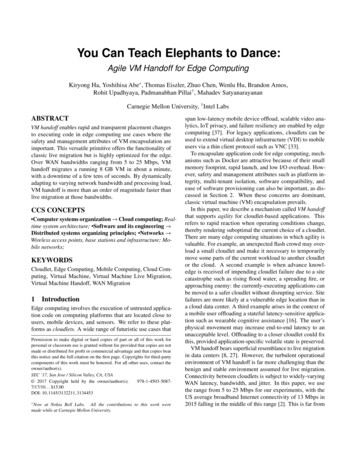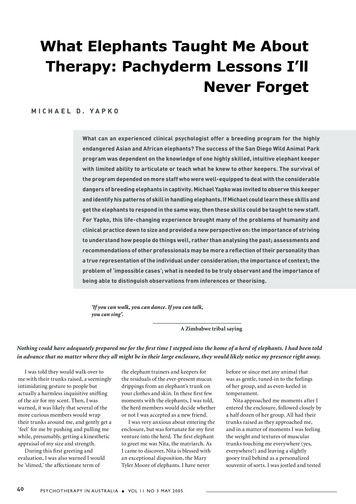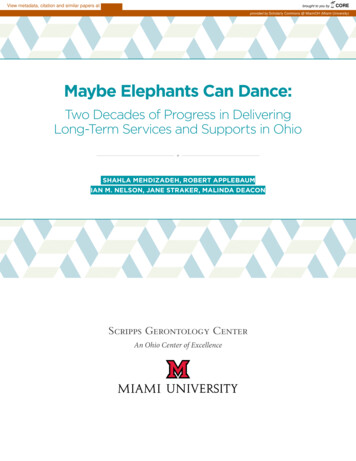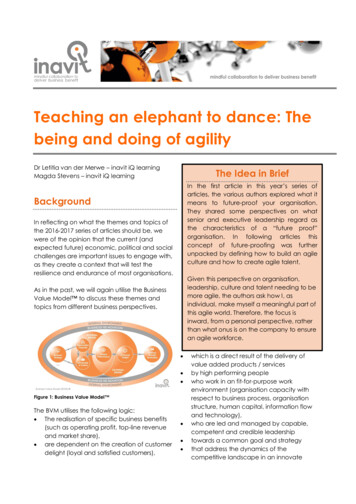
Transcription
You Can Teach Elephants to Dance:Agile VM Handoff for Edge ComputingKiryong Ha, Yoshihisa Abe , Thomas Eiszler, Zhuo Chen, Wenlu Hu, Brandon Amos,Rohit Upadhyaya, Padmanabhan Pillai† , Mahadev SatyanarayananCarnegie Mellon University, † Intel LabsABSTRACTVM handoff enables rapid and transparent placement changesto executing code in edge computing use cases where thesafety and management attributes of VM encapsulation areimportant. This versatile primitive offers the functionality ofclassic live migration but is highly optimized for the edge.Over WAN bandwidths ranging from 5 to 25 Mbps, VMhandoff migrates a running 8 GB VM in about a minute,with a downtime of a few tens of seconds. By dynamicallyadapting to varying network bandwidth and processing load,VM handoff is more than an order of magnitude faster thanlive migration at those bandwidths.CCS CONCEPTS Computer systems organization Cloud computing; Realtime system architecture; Software and its engineering Distributed systems organizing principles; Networks Wireless access points, base stations and infrastructure; Mobile networks;KEYWORDSCloudlet, Edge Computing, Mobile Computing, Cloud Computing, Virtual Machine, Virtual Machine Live Migration,Virtual Machine Handoff, WAN Migration1IntroductionEdge computing involves the execution of untrusted application code on computing platforms that are located close tousers, mobile devices, and sensors. We refer to these platforms as cloudlets. A wide range of futuristic use cases thatPermission to make digital or hard copies of part or all of this work forpersonal or classroom use is granted without fee provided that copies are notmade or distributed for profit or commercial advantage and that copies bearthis notice and the full citation on the first page. Copyrights for third-partycomponents of this work must be honored. For all other uses, contact theowner/author(s).SEC ’17, San Jose / Silicon Valley, CA, USA 2017 Copyright held by the owner/author(s).978-1-4503-50877/17/10. . . 15.00DOI: 10.1145/3132211.3134453 Nowat Nokia Bell Labs. All the contributions to this work weremade while at Carnegie Mellon University.span low-latency mobile device offload, scalable video analytics, IoT privacy, and failure resiliency are enabled by edgecomputing [37]. For legacy applications, cloudlets can beused to extend virtual desktop infrastructure (VDI) to mobileusers via a thin client protocol such as VNC [33].To encapsulate application code for edge computing, mechanisms such as Docker are attractive because of their smallmemory footprint, rapid launch, and low I/O overhead. However, safety and management attributes such as platform integrity, multi-tenant isolation, software compatibility, andease of software provisioning can also be important, as discussed in Section 2. When these concerns are dominant,classic virtual machine (VM) encapsulation prevails.In this paper, we describe a mechanism called VM handoffthat supports agility for cloudlet-based applications. Thisrefers to rapid reaction when operating conditions change,thereby rendering suboptimal the current choice of a cloudlet.There are many edge computing situations in which agility isvaluable. For example, an unexpected flash crowd may overload a small cloudlet and make it necessary to temporarilymove some parts of the current workload to another cloudletor the cloud. A second example is when advance knowledge is received of impending cloudlet failure due to a sitecatastrophe such as rising flood water, a spreading fire, orapproaching enemy: the currently-executing applications canbe moved to a safer cloudlet without disrupting service. Sitefailures are more likely at a vulnerable edge location than ina cloud data center. A third example arises in the context ofa mobile user offloading a stateful latency-sensitive application such as wearable cognitive assistance [16]. The user’sphysical movement may increase end-to-end latency to anunacceptable level. Offloading to a closer cloudlet could fixthis, provided application-specific volatile state is preserved.VM handoff bears superficial resemblance to live migrationin data centers [8, 27]. However, the turbulent operationalenvironment of VM handoff is far more challenging than thebenign and stable environment assumed for live migration.Connectivity between cloudlets is subject to widely-varyingWAN latency, bandwidth, and jitter. In this paper, we usethe range from 5 to 25 Mbps for our experiments, with theUS average broadband Internet connectivity of 13 Mbps in2015 falling in the middle of this range [2]. This is far from
SEC ’17, October 12–14, 2017, San Jose / Silicon Valley, CA, USAApp1 periodically sends accelerometer readings from amobile device to a Linux back-end that performs acompute-intensive physics simulation [39], and returnsan image to be rendered.App2 ships an image from a mobile device to aWindows back-end, where face recognition isperformed [42] and labels corresponding to identifiedfaces are returned.App3 [41] is an augmented reality application that shipsan image from a mobile device to a Windows back-endthat identifies landmarks, and returns a modified imagewith these annotations.App4 ships an image from a mobile device to a Linuxback-end that performs object detection [9], and returnsthe labels of identified objects.Figure 1: Offload Benchmark Suite for Edge Computingthe 1–40 Gbps, low-latency and low-jitter connectivity thatis typically available within data centers. VM handoff alsodiffers from live migration in the primary performance metricof interest. Down time, which refers to the brief periodtowards the end when the VM is unresponsive, is the primarymetric in live migration. In contrast, it is total completiontime rather than down time that matters for VM handoff. Inmost use cases, prolonged total completion time defeats theoriginal motivation for triggering the operation. Abe et al [1]have shown that a narrow focus on down time can lead toexcessive total completion time.The essence of our design is preferential substitution ofcloudlet computation for data transmission volume. VM handoff dynamically retunes this balance in the face of frequentbottleneck shifts between cloudlet processing and networktransmission. Using a parallelized computational pipeline tomaximize throughput, it leverages a variety of data reductionmechanisms. We develop an analytic model of our pipeline,and derive an adaptation heuristic that is sensitive to varyingbandwidth and cloudlet load. Our experiments confirm thatVM handoff is agile, and reduces total completion time byone to two orders of magnitude relative to live migration.However, scalability and performance are not the only attributes of interest in edge computing. There are at least fourother important attributes to consider. The first is safety: protecting the integrity of cloudlet infrastructure from potentiallymalicious application software. The second is isolation: hiding the actions of mutually untrusting executions from eachother on a multi-tenant cloudlet. The third is transparency:the ability to run unmodified application code without recompiling or relinking. Transparency lowers the barrier toentry of cloudlet-based applications because it allows reuseof existing software for rapid initial deployment and prototyping. Refactoring or rewriting the application software touse lighterweight encapsulation can be done at leisure, afterinitial validation of the application in an edge computing context. A huge body of computer vision and machine learningsoftware thus becomes immediately usable at the edge, closeto sensors and video cameras. Transparency is especiallyvaluable in use cases such as VDI, where the source code tolegacy software may not be available. A fourth attribute isdeployability: the ability to easily maintain cloudlets in thefield, and to create mobile applications that have a high likelihood of finding a software-compatible cloudlet anywhere inthe world [17]. Lighterweight encapsulation typically comesat the cost of deployability. A Docker-encapsulated application, for example, uses the services of the underlying hostoperating system and therefore has to be compatible with it.Process migration is an example of a lightweight service thathas proven to be brittle and difficult to maintain in the field,even though there have been many excellent experimentalimplementations [4, 14, 30, 48].For these four attributes, classic VM encapsulation is superior to lighterweight encapsulation techniques. Clearly, theoptimal choice of encapsulation technique will be contextspecific. It will depend on the importance of these attributesrelative to memory footprint and CPU overhead. A hybridapproach, such as running many Docker containers within anouter encapsulating VM, is also possible.In addition to these four attributes, the attribute of agilitythat was introduced in Section 1 is especially relevant. VMhandoff is a mechanism that scores well on all five of thesesafety and management attributes for edge computing.32VM Encapsulation for Edge ComputingThere are opposing tensions in the choice of an encapsulationmechanism for edge computing. One key consideration is thememory footprint, launch speed and I/O performance degradation induced by the container. Lightweight mechanismssuch as Docker minimally burden a cloudlet, and hence offergood scalability and return on hardware investment. Evenlighterweight encapsulation is possible by simply using theUnix process abstraction as a container.Ha et alPoor Agility of Live MigrationWithin a data center, live migration [8, 27] is widely used toprovide the functionality targeted by VM handoff. Its designis optimized to take full advantage of LANs. Efforts to extendlive migration to work over long distances [3, 26, 47] typicallyrely on dedicated high-bandwidth links between end points.The few works targeting low bandwidth migration [6, 49]either slow the running VM, or use a post-copy approachwhich may result in erratic application performance that isunacceptable for latency-sensitive use cases.
Agile VM HandoffVMTotal timeDown timeApp3 3126s (39%) 7.63s (11%)App4726s (1%) 1.54s (20%)SEC ’17, October 12–14, 2017, San Jose / Silicon Valley, CA, USATransfer Size3.45 GB (39%)0.80 GB (1%)Average and Relative standard deviation of 3 runs. Theseresults are extracted as a preview of Figure 7 in Section 5.3See Figure 7 for full details.Figure 2: Total Completion Time of Live Migration (10 Mbps)To illustrate the suboptimal behavior of live migration overWANs, we briefly preview results from experiments that arereported later in Section 5.3. Figure 1 describes the benchmark suite that is used for all experimental results reportedin this paper. This suite is representative of latency-sensitiveworkloads in edge computing. Each application in the suiteruns on an Android mobile device, and offloads computationin the critical path of user interaction to a VM-encapsulatedapplication backend on a cloudlet. That VM is configuredwith an 8 GB disk and 1 GB of memory. The VMM on thecloudlet is QEMU/KVM 1.1.1 on Ubuntu Linux.Figure 2 presents the total completion times of live migration at a bandwidth of 10 Mbps. App4 takes 726 secondsto complete, which is hardly agile relative to the timeframesof cloudlet overload and imminent site failures discussed inSection 1. App3 suffers even worse. It requires a total completion time of 3126 seconds, with high variance. This is dueto background activity in the Windows 7 guest that modifiesmemory fast enough to inordinately prolong live migration.We show later that VM handoff completes these operationsmuch faster: 66 seconds and 258 seconds respectively.The poor agility of live migration for edge computing isnot specific to QEMU/KVM. Abe et al. [1] have shown thatlong total completion times are also seen with live migrationimplementations on other hypervisors such as Xen, VMware,and VirtualBox. In principle, one could retune live migrationparameters to eliminate a specific pathological behavior suchas App3 above. However, these parameter settings would haveto be retuned for other workloads and operating conditions.Classic live migration is a fine mechanism within a bandwidthrich data center, but suboptimal across cloudlets.4Basic Design and ImplementationVM handoff builds on three simple principles: Every non-transfer is a win. Use deduplication, compression and delta-encoding to ruthlessly eliminateavoidable transfers. Keep the network busy. Network bandwidth is aprecious resource, and should kept at the highestpossible level of utilization. Go with the flow. Adapt at fine time granularity tonetwork bandwidth and cloudlet compute resources.Figure 3 shows the overall design of VM handoff. Pipelinedprocessing is used to efficiently find and encode the differences between current VM state at the source and alreadypresent VM state at the destination (Section 4.1 and 4.2).This encoding is then deduplicated and compressed usingmulticore-friendly parallel code, and then transferred (Section 4.3). We describe these aspects of VM handoff in thesections below. For dynamic adaptation, the algorithms andparameters used in these stages are dynamically selected tomatch current processing resources and network bandwidth.We defer discussion of these mechanisms until Section 6.4.1Leveraging Base VM ImagesVM handoff extends previous work on optimizations for content similarity on disk [29, 31], memory [15, 43], and rapidVM provisioning [17]. It leverages the presence of a baseVM at the destination: data blocks already present there donot have to be transferred. Even a modestly similar VM issufficient to provide many matching blocks. A handful ofsuch base VMs are typically in widespread use at any giventime. It would be straightforward to publish a list of suchbase VMs, and to precache all of them on every cloudlet. Ourexperiments use Windows 7 and Ubuntu 12.04 as base VMimages. It should be noted that the correctness of VM handoffis preserved even though its performance will be affected bythe absence of a base VM image at the destination.4.2Tracking ChangesTo determine which blocks to transmit, we need to track differences between a VM instance and its base image. Whena VM instance is launched, we first identify all the blocksthat are different from the base VM. We cache this information in case of future launches of same image. It is alsopossible to preprocess the image and warm the cache evenbefore the first launch. To track changes to a running VMdisk state, VM handoff uses the Linux FUSE interface to implement a user-level filesystem on which the VM disk imageis stored. All VM disk accesses pass through the FUSE layer,which can efficiently and accurately track modified blocks.A list of modified disk blocks relative to the base image ismaintained, and is immediately available when migration istriggered. Since FUSE is used only for hooking, it does notbreak compatibility with the existing virtual disk image. Inour implementation, we use raw virtual disk format but otherformats can also be supported if needed. Also, as in [28], wehave found that FUSE has minimal impact on virtual diskaccesses, despite the fact that it is on the critical read andwrite paths from the VM to its disk.Tracking VM memory modifications is more difficult. AFUSE-like approach would incur too much overhead on everymemory write. Instead, we capture the memory snapshot atmigration, and determine the changed blocks in our code. To
SEC ’17, October 12–14, 2017, San Jose / Silicon Valley, CA, USAGuest OSQEMU/KVMFuse LibraryModifieddisk blocksDisk DiffModifiedmemory pagesMemory DiffOperatingModeDynamicAdaptationPipelined stagesDeduplication Xdelta3 XOR Bsdiff No diffHa et al Disk dedupProcess Memory dedupManager Self dedupCompressionInternet (WAN) Comp Algorithm Comp LevelFigure 3: Overall System Diagram for VM handoff1,200Size (MB)1,00080054%600400200029%22%40%13% 9%36%9% 7%App1App2App343%19%13%App4Xdelta3 and LZMA level 9 for compressionFigure 4: Cumulative Reductions in VM State Transferget the memory state, we leverage QEMU/KVM’s built-in livemigration mechanism. When we trigger this mechanism, itmarks all VM pages as read-only to trap and track any furthermodifications. It then starts a complete transfer of the memorystate. We redirect this transfer to new VM handoff stagesin the processing pipeline. As described in the followingsubsections, these stages filter out unmodified pages relativeto the base VM, and then delta-encode, deduplicate, andcompress the remaining data before transmission.After this initial step, the standard iterative process forlive migration takes over. On each iteration, the modifiedpages identified by QEMU/KVM are passed through thedelta-encoding, deduplication and compression stages of ourpipeline. During this process, it tries to leverage the baseVM’s memory as much as it can if the base VM’s memoryis found at the destination. To limit repeated transmission ofhot pages, VM handoff regulates the start of these iterationsand limits how many iterations are performed.4.3Reducing the Size of Transmitted DataVM handoff implements a pipeline of processing stages toshrink data before it reaches the network. The cumulativereduction achieved by this pipeline can be substantial. Forthe four applications listed in Figure 1, the volume of datatransferred is typically reduced to between 1/5 and 1/10 ofthe total modified data blocks. Figure 4 presents these resultsin more detail, showing the effect of individual stages in thepipeline. We describe these stages below.Delta encoding of modified pages and blocks: The streamsof modified disk blocks and all VM memory pages are fed totwo delta encoding stages (Disk diff and Memory diff stagesin Figure 3). The data streams are split into 4KB chunks, andare compared to the corresponding chunks in the base VMusing their (possibly cached) SHA-256 hash values. Chunksthat are identical to those in the base VM are omitted.For each modified chunk, we a use binary delta algorithmto encode the difference between the chunk and its counterpart in the base VM image. If the encoding is smaller than thechunk, we transmit the encoding. The idea here is that smallor partial modifications are common, and there may be significant overlap between the modified and original block whenviewed at fine granularities. VM handoff can dynamicallychoose between xdelta3, bsdiff4, or xor to performthe binary delta encoding, or to skip delta encoding. We parallelize the compute-intensive hash computations and the deltaencoding steps using multiple threads.Deduplication: The streams of modified disk and memorychunks, along with the computed hash values, are merged andpassed to the deduplication stage. Multiple copies of the samedata commonly occur in a running VM. For example, thesame data may reside in kernel and user-level buffers, or ondisk and OS page caches. For each modified chunk, we compare the hash value to those of (1) all base VM disk chunks,(2) all base VM memory chunks, (3) a zero-filled chunk, (4)all prior chunks seen by this stage. The last is important tocapture multiple copies of new data in the system, in eitherdisk or memory. This stage filters out the duplicates that arefound, replacing them with pointers to identical chunks inthe base VM image, or that were previously emitted. As theSHA-256 hash used for matching was already computed inthe previous stage, deduplication reduces to fast hash lookupsoperations and can therefore run as a single thread.Compression: Compression is the final stage of the data reduction pipeline. We apply one of several off-the-shelf compression algorithms, including GZIP (deflate algorithm) [12],BZIP2 [7], and LZMA [45]. These algorithms vary significantly in the compression achieved and processing speed.As compression works best on bulk data, we aggregate themodified chunk stream into approximately 1 MB segments
Agile VM HandoffSEC ’17, October 12–14, 2017, San Jose / Silicon Valley, CA, USASnapshotMemory diffDisk diffDedupCompressionTransfer Is VM handoff able to scale well by making gooduse of extra cores on a cloudlet? (Section 5.4)0204060 80 100 120 140Seconds since start160180(a) Serial ProcessingSnapshotMemory diffDisk diffDedupCompressionTransfer0204060 80 100 120 140Seconds since start160180(b) Pipelined ProcessingApp4: xdelta3 and LZMA level 5Figure 5: Serial versus Pipelined Data Reductionbefore applying compression. We leverage multicore parallelism in this processing-intensive stage by running multipleinstances of the compression algorithms in separate threads,and sending data segments to them round-robin.4.4Pipelined ExecutionThe data reduction stages described in the preceding sections ensure that only high-value data reaches the network.However, because of the processing-intensive nature of thesestages, their serial execution can result in significant delaybefore the network receives any data to transmit. The networkis idle during this delay, and this represents a lost opportunity.Under conditions of low bandwidth, keeping the networkfilled with high-value data is crucial to good performance.VM handoff pipelines the data reduction stages in order tofill the network as quickly as possible. This has the addedbenefit of reducing the amount of memory needed to bufferthe intermediate data generated by the upstream stages, asthey are consumed quickly by downstream stages. Figure 5illustrates the benefit of VM handoff’s pipelined implementation. In this example, total migration time is reduced by36% (from 171.9 s down to 110.2 s).5Evaluation of Basic DesignIn this section, we evaluate the performance of VM handoffunder stable conditions that do not require dynamic adaptation. We defer evaluation under variable conditions until theadaptation mechanisms of VM handoff have been presentedin Section 6. We answer the following questions here: Is VM handoff able to provide short total migrationtime on a slow WAN? (Section 5.2) Does VM handoff provide a significant performancewin over live migration? How does it compare withnon-VM approaches such as Docker? (Section 5.3)5.1Experimental SetupOur experiments emulate WAN-like conditions using theLinux Traffic Control (tc [25] tool), on physical machinesthat are connected by gigabit Ethernet. We configure bandwidth in a range from 5 Mbps to 25 Mbps, according to theaverage bandwidths observed over the Internet [2, 46], anduse a fixed latency of 50 ms. To control computing resourceavailability, we use CPU affinity masks to assign a fixed number of CPU cores to our system. Our source and destinationcloudlet machines have an Intel Core i7-3770 processor(3.4 GHz, 4 cores, 8 threads) and 32 GB main memory. Tomeasure VM down time, we synchronize time between thesource and destination machines using NTP. For differenceencoding, our system selects from xdelta3, bsdiff, xor,or null. For compression, it uses the gzip, bzip2, or LZMAalgorithms at compression levels 1–9. All experiments usethe benchmark suite in Figure 1, and start with the VM instance already running on the source cloudlet. Since theseexperiments focus on the non-adaptive aspects of VM handoff, the internal parameter settings remain stable throughouteach experiment. Their initial values are chosen as describedfor the adaptive cases of Section 6.5.2Performance on WANsFigure 6 presents the overall performance of VM handoff overa range of network bandwidths. Total time is the total durationfrom the start of VM handoff until the VM resumes on thedestination cloudlet. A user may see degraded applicationperformance during this period. Down time, which is includedin total time, is the duration for which the VM is suspended.Even at 5 Mbps, total time is just a few minutes and downtime is just a few tens of seconds for all workloads. These areconsistent with user expectations under such challenging conditions. As WAN bandwidth improves, total time and downtime both shrink. At 15 Mbps using two cores, VM handoffcompletes within one minute for all of the workloads exceptApp3, which is an outlier in terms of size of modified memorystate (over 1 GB, see Figure 4). The other outlier is App1,whose modified state is too small for effective adaptation.More bandwidth clearly helps speed up total completiontime. Note, however, that the relationship of completion timeto bandwidth is not a simple linear inverse. Two factors makeit more complex. First, at low bandwidths, slow data transfersgive the VM more time to dirty pages, increasing the totaldata volume and hence transfer time. On the other hand, thesequantities are reduced by the fact that VM handoff has moretime to compress data. The relative effects of these opposingfactors can vary greatly across workloads.
SEC ’17, October 12–14, 2017, San Jose / Silicon Valley, CA, USAHa et alBW5 Mbps10 Mbps15 Mbps20 MbpsTime (s) TotalDownTotalDownTotalDownTotalDownApp 125.14.0 ( 5%) 24.63.2 (29%) 23.92.9 (38%)23.9 3.0 (38%)App 2247.0 24.3 ( 3%) 87.4 15.1 (10%) 60.3 11.4 ( 8%)46.9 7.0 (14%)App 3494.4 24.0 ( 4%) 257.9 13.7 (25%) 178.28.8 (19%) 142.1 7.1 (24%)App 4113.9 15.8 ( 6%) 66.97.3 (42%) 52.85.3 (12%)49.1 6.9 (12%)(a) 1 CPU core25 MbpsTotalDown24.0 2.9 (43%)39.3 5.7 (25%)121.4 7.8 (22%)45.0 7.1 (30%)BW5 Mbps10 Mbps15 MbpsTime (s) TotalDownTotalDownTotalDownApp 117.34.1 ( 6%) 15.72.5 ( 4%) 15.6 2.2 (14%)App 2245.5 26.5 ( 7%) 77.4 14.7 (24%)48.5 6.7 (15%)App 3493.4 24.5 (10%) 250.8 12.6 (13%) 170.4 9.0 (17%)App 4111.6 17.2 ( 7%) 58.65.5 ( 5%) 43.6 5.5 (31%)(b) 2 CPU cores25 MbpsTotalDown15.2 1.9 (20%)31.3 4.1 (17%)109.8 6.5 (22%)30.2 2.1 (26%)20 MbpsTotalDown15.4 2.0 (19%)36.1 3.6 (12%)132.3 7.3 (20%)34.1 2.1 (22%)Average of 5 runs and relative standard deviations (RSDs, in parentheses) are reported. For total migration times, the RSDs arealways smaller than 9%, generally under 5%, and omitted for space. For down time, the deviations are relatively high, as this canbe affected by workload at the suspending machine.Figure 6: Total Completion Time and Down Time of VM handoff on WANsVMApp1App2App3App4ApproachVM handoffLive MigrationVM handoffLive MigrationVM handoffLive MigrationVM handoffLive MigrationTotaltime (s)16 (3 %)229 (1 %)77 (4 %)6243 (68 %)251 (1 %)3126 (39 %)59 (1 %)726 (1 %)Downtime (s)2.5 (4%)2.4 (22 %)14.7 (24 %)5.5 (17 %)12.6 (13 %)7.6 (11 %)5.5 (5 %)1.5 (20 %)Transfersize (MB)723584689927635336182Total Down TransfertimetimesizeVM handoff 15.7s2.5s7.0 MBApp1Docker6.9s6.9s6.5 MBVM handoff 58.6s5.5s61 MBApp4Docker118s118s98 MBOnly App1 and App4 are shown becauseDocker-CRIU works for only Linux Apps.VMFigure 7: VM handoff vs. KVM/QEMU Live Migration at 10 Mbps5.3Comparison to AlternativesWhat is the agility of VM handoff relative to alternatives?Figure 7 contrasts VM handoff and QEMU/KVM live migration (version 1.1.1) between two cloudlets connected bya 10 Mbps, 50 ms RTT WAN. The WAN is emulated byLinktropy hardware on a gigabit Ethernet. There is no sharedstorage between cloudlets. To ensure a fair comparison, livemigration is configured so that the destination cloudlet alreadyhas a copy of the base VM image into which the applicationand its supporting toolchain were installed to construct thebenchmark VM. These “pre-copied” parts of the benchmarkVM state do not have to be transferred by live migration.In other words, the comparison already factors into live migration a component source of efficiency for VM handoff.Despite this, live migration performs poorly relative to VMhandoff. For every app in the benchmark suite, VM handoffimproves total completion time by an order of magnitude.ApproachFigure 8: VM handoff vs. Docker at 10 MbpsLive migration would perform even worse if the base VMwere not present at the destination. For example, our experiments take over two hours for App4, and two and a half hoursfor App3. We omit the detailed results to save space.How much would lighterweight encapsulation improveagility? To explore this question, we compare VM handoff with Docker [13]. Although Docker does not nativelysupport migration of a running container, a form of migration can be achieved with Checkpoint/Restore in Userspace(CRIU) [10]. This involves suspending the container andcopying memory and disk state to the destination. So, unlikeVM handoff, down time equals total completion time.Figure 8 compares VM handoff to Docker migration for thetwo Linux applications in our benchmark suite (Docker-CRIUonly works for Linux apps). Given the reputation of VM encapsulation as being heavyweight and unwieldy, we wouldexpect the agility of VM handoff to be horrible relative toDocker migration. In fact, the results are far more reassuring.
Processing throughput (Mbps)Agile VM Handoff150100SEC ’17, October 12–14, 2017, San Jose / Silicon Valley, CA, USAApp1App2App3App4500123of CPU cores4Figure 9: Processing Scalability of the SystemFor App4, VM handoff is actually twice as fast as Docker.For App1, the total state is so small that the VM handoff optimizations do not really kick in. Though Docker takes roughlyhalf the total completion time, its down time is significantlylonger than that of VM handoff.From the viewpoint of agility, VM encapsulation is thussurprisingly inexpensive in light of its safety and managementbenefits that were discussed in Section 2. The issue of largememory footprint and CPU overhead continue to be concernsfor VM encapsulation, but agility need not be a concern.5.4Multicore ScalabilityThe pipelining in VM handoff enables good use to be made ofextra cloudlet cores. Figure 9 shows the processing throughput for different workloads as the number of CPU cores increases. For Apps 2–4, the improvement is almost linearas we use more cores. For App1, the total volume of dataprocessed is too small to benefit from multiple cores.5.5Importance of Memory StateAs mentioned in Section 4.1, VM handoff aggressively leverages available state at the destination cloudlet to minimizetransfer size.
You Can Teach Elephants to Dance: Agile VM Handoff for Edge Computing Kiryong Ha, Yoshihisa Abe, Thomas Eiszler, Zhuo Chen, Wenlu Hu, Brandon Amos, Rohit Upadhyay










